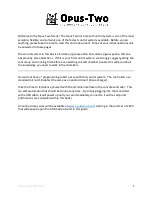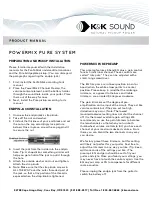
TGA-3 100 Watt Guitar Amplifier User’s Guide
Gain Switch
The red channel also has an FX send/submaster. To the right of this control and the dark switch is the gain
switch, marked hot and hotter. On the ‘hot’ setting, this cuts the gain and feedback down 12dB, for a more
tightly-controlled sound. If it’s out-of-control you want, set it to ‘hotter’ for more feedback and harmonic
sustain. At extreme volume settings, hotter will cause harmonics to feed back an octave higher. Remember: the
gain switch, the dark switch, red tone controls, and FX send/submaster are common to channels 2 (green) and 3
(red). The edge/lead switch is for channel 2 only.
FX Send/Submasters
A word about the FX send/submasters: with or without effects, these controls act as two “second-master”
volumes, and can be useful in lower-volume situations to get a more “cranked-up” tone. The interplay of the gain,
master and FX send/submaster also makes subtle changes in the quality of the overdrive, and can help in the
achievement of a “loud” sound when recording or miking cabs on stage.
FX Loop Returns
To the right of the (yellow) FX send/submaster are the (blue) stereo FX loop return controls, left and right. As
previously mentioned, the right return also controls the volume of a slave amplifier, whether. When effects or an
amp is connected to this circuit, the returns become another ‘submaster’ control, with still more subtle changes
in the ‘sound’ possible.
Presence Control
Further right is the (blue) presence control, similar to the presence knob on Fender and Marshall amps. It gives
overall brightness to all amp settings. Note: This control will make a small amount of noise when rotated. This
is normal for this type of control, as in original “tweed” Fenders and “plexi” Marshalls.
Power/Standby
Furthest right are the standby and power switches. The arrangement is similar to a Fender, with a pilot LED for
the power switch, Standby provides for instant power-up without warmup time, and keeps tube filaments hot
for longer tube life.
There you have it. Thank you for being patient and reading this manual. All that remains is for you to connect
your speakers, make the necessary connections, and throw the switches. Start with the master volumes on
low, then put everything else at 12 o’clock to preset your volumes. Then add tone and gain ‘to taste’! We encour
-
age you to experiment!
If you have any further questions, feel free to call us.
Written by Michael Gabriel. Thanks to James Demeter, Mike Amundson and Bill Lay for editorial assistance.
6900 Kingsbury Road | Templeton, CA 93465 | 805-461-4100 | http://www.demeteramps.com/
























